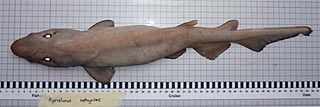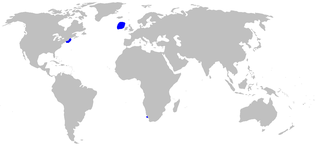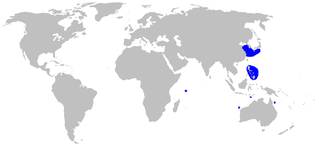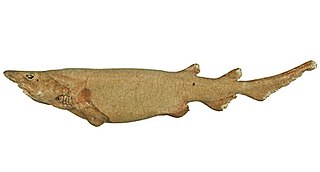
Catsharks are ground sharks of the family Scyliorhinidae. They are the largest family of sharks with around 160 species placed in 17 genera. Although they are generally known as catsharks, some species can also be called dogfish due to previous naming. However, a dogfish may generally be distinguished from a catshark as catsharks lay eggs while dogfish have live young. Like most bottom feeders, catsharks feed on benthic invertebrates and smaller fish. They are not harmful to humans. The family is paraphyletic, containing several distinct lineages that do not form a monophyletic group.

The brown catshark is commonly found in the Pacific Ocean, ranging from the northern Pacific waters off the coast of British Columbia and south to the Baja California peninsula in Mexico. They may live as far south as Ecuador and Peru. Brown catsharks are deep-water sharks that live on the outer continental shelf and the upper slope. They have been known to live at depths ranging from 30 to 650 m and live on the bottom, usually in muddy or sandy areas. The brown catshark, when originally described, was called Catulus brunneus.

Apristurus is a genus of catsharks, the family Pentanchidae, the deepwater catsharks. The species in this genus are commonly known as the ghost or demon catsharks.

Galeus is a genus of catshark, belonging to the family Scyliorhinidae, commonly known as sawtail catsharks in reference to a distinctive saw-toothed crest of enlarged dermal denticles, found along the upper edges of their caudal fins. They are found in the Atlantic, the western and central Pacific, and the Gulf of California, inhabiting deep waters at or close to the sea floor. Members of this genus are rather small, slim sharks with firm bodies and thick, rough skin. Their heads are usually fairly long and pointed, and have large mouths with well-developed furrows at the corners. They have large pectoral and anal fins, and two similar dorsal fins placed well back. Many species are ornately patterned with dark saddles and/or blotches. Sawtail catsharks feed on various invertebrates and fishes, and may be either egg-laying or live-bearing. These harmless sharks are sometimes caught as bycatch but are of minimal commercial value.

The mouse catshark is a species of catshark and part of the family Scyliorhinidae. It is common in the northeastern Atlantic Ocean from Iceland to Western Sahara. There is much taxonomic confusion regarding this species in Icelandic waters, where it may be confounded with another species of Galeus or Apristurus. Probably not exceeding 49 cm (19 in) long, the mouse catshark has a uniformly brown body and is characterized by large, rounded pelvic fins and crests of enlarged dermal denticles along both the dorsal and ventral caudal fin margins. In addition, in adult males the inner margins of the pelvic fins are merged into an "apron".

The white ghost catshark is a shark of the catshark family Pentanchidae, the deepwater catsharks. This shark is found in deep water in the northeast Atlantic between latitudes 57°N and 58°N. A deep-water catshark known from the eastern North Atlantic from depths of 1,014 to 1,800 m, it is known from only a limited number of specimens. It reaches a maximum of 54 cm or 1.7 ft total length which is a medium size for the Apristurus genus.

The smallbelly catshark is a shark of the family Pentanchidae, the deepwater catsharks. This species is found in the western Indian Ocean near Somalia, the Gulf of Aden, and Oman, at depths between 1,300 and 1,840 m. Its length is up to 34 cm, although this measurement is of an immature specimen. The smallbelly catshark is not well known. It is found on continental slopes, and is probably caught by bottom trawlers. The reproduction of the smallbelly catshark is oviparous.

The shortnose demon catshark is a shark of the family Pentanchidae, the deepwater catsharks. This species is found only in deep water in the East China Sea. Its length is up to 40 cm. A. internatus is known only from the holotype and a paratype, both caught in the East China Sea, probably taken as bycatch in deepwater trawl fisheries. The reproduction of this catshark is oviparous.

The bulldog catshark is a catshark of the family Scyliorhinidae, found in the deep waters of the East China Sea and in the Northwest Pacific. In New Zealand waters it is found at the Reinga Ridge, the West Norfolk Ridge, the Hikurangi Trough and the Chatham Rise as well as on the Campbell Plateau.

The Saldanha catshark is a species of catshark, belonging to the family Scyliorhinidae. This catshark is found from Cape Columbine to south of False Bay in South Africa, between 31 and 40°S. Its length is up to 88 cm. It is a plain, dark grey-brown, stout catshark, with moderately large eyes, a broad snout, and large pectoral fins.

The largenose catshark is a catshark of the family Scyliorhinidae. The largenose catshark is found on the upper continental slopes in the eastern Pacific, from the Gulf of Panama to Ecuador and central Chile, between 9°N and 28°S. It can grow up to 70 cm. Its reproduction is oviparous. This nose shark is considered to be a harmless species. It is known to originate from the Gulf of Panama, Ecuador, and Central Chile.

The ghost catshark is a species of shark belonging to the family Pentanchidae, the deepwater catsharks. This species is found on the continental slopes in the northwest Atlantic off Massachusetts, the northeast Atlantic from the Porcupine Bank west of Ireland and the southern Atlantic off Cape Town, at depths between 600 and 1,900 metres.

The broadnose catshark is a shark of the family Pentanchidae, the deepwater catsharks. The holotype and only specimen being found in deep water in the Andaman Sea in the Indian Ocean between 16 and 10°N. Its length is around 26 cm, although this measurement was taken from an immature specimen. The reproduction of this catshark is oviparous. The threats are not exactly known but it may be deepwater fisheries.

The longhead catshark or smoothbelly catshark is a species of shark, family Pentanchidae, the deepwater catsharks. This shark has a patchy distribution in the Indo-Pacific from Mozambique to southern Japan to northern Australia. It is found in water between 500 and 1,140 m deep. This species grows to 59 cm (23 in) long and is characterized by its extremely long and narrow snout, short abdomen, and long anal and caudal fins. In addition, a large area of the anterior ventral portion of its body lacks dermal denticles. The longhead catshark is oviparous and the only known cartilaginous fish that is normally hermaphroditic, with the majority of individuals having both the functional reproductive organs of one sex and the undeveloped reproductive organs of the opposite sex.
The roughskin catshark is a species of catshark in the family Pentanchidae, the deepwater catsharks. This species is found near Australia and New Zealand. Its natural habitat is the open seas. This species belongs to a genus of poorly known deep-water catsharks.

The bighead catshark is a species of fish in the family Pentanchidae, the deepwater catsharks. This species is endemic to Australia. Its natural habitat is the open seas. It belongs to a genus of poorly known deep-water catsharks, and is recorded from only three specimens taken off Perth, Western Australia. This species could be rare or uncommon, and the effects of fisheries are unknown, though if its biology is like other deep-water shark species, it may not be sufficiently fecund to withstand exploitation pressures.
The milk-eye catshark (Apristurus nakayai) is a species of shark in the family Scyliorhinidae found in Coriolis Bank off western New Caledonia. Its natural habitat is the open seas. The new deep-water catshark, Apristurus nakayai, is described from northern New Caledonian waters.
Garrick's catshark is a species of shark in the family Pentanchidae, the deepwater catsharks. This species is found in the waters of New Zealand. Its natural habitat is the open seas. The new deep-water catshark, Apristurus garricki, is described from the waters of northern New Zealand. It is named in honour of Jack Garrick.

Fedorov's catshark is a shark of the family Pentanchidae, the deepwater catsharks. This shark has oviparous reproduction. This is a very poorly known species, with less than 30 specimens reported in the scientific literature. Almost nothing is known of its biology. This species may be endemic to northern Japanese waters, where it is taken in water around 1,200 m deep. However, accurate identification of Apristurus species is particularly difficult, and further research is required to determine its geographical and bathymetrical distribution.
The shortbelly catshark is a shark of the family Pentanchidae, the deepwater catsharks. It is found in the Gulf of Aden, Indian Ocean. This species most closely resembles the western Atlantic species Apristurus canutus, but is distinguishable in having greater nostril length than internarial width and longer claspers in adult males.

















